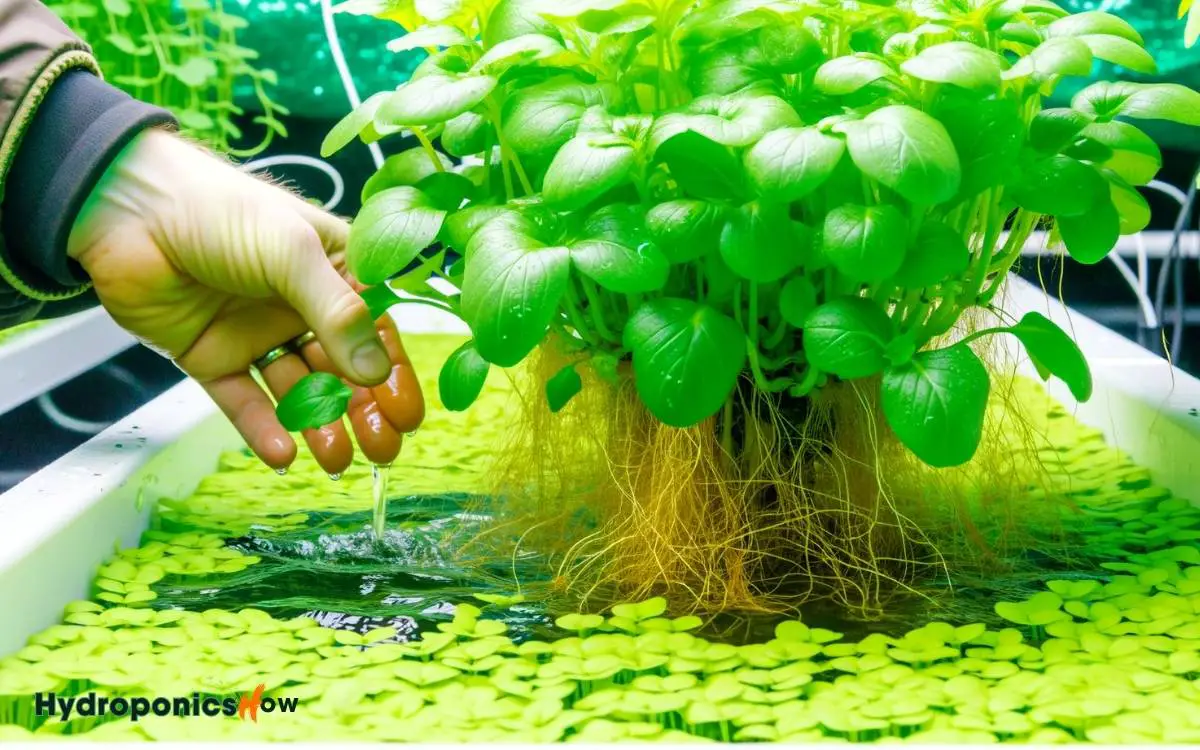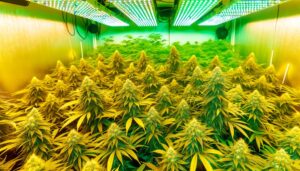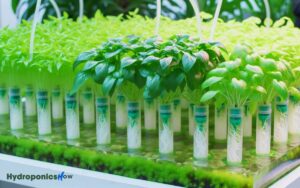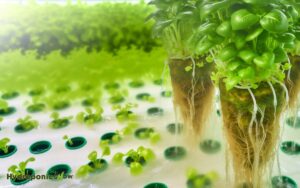How to Use Inoculants for Hydroponic Plants
Yes, you can use inoculants in hydroponic plants. Inoculants, including beneficial bacteria like Bacillus and fungi such as mycorrhizal species, play a critical role in enhancing nutrient uptake, improving plant health, and increasing disease resistance.
These microorganisms form symbiotic relationships with plant roots, converting essential nutrients into bioavailable forms and facilitating efficient absorption.
Applying these inoculants in hydroponic systems promotes robust root development and enhances overall plant vigor.
Selecting the appropriate inoculant type based on plant species and growth stage guarantees maximum efficacy.
For a thorough understanding of the benefits and application methods, continue exploring the intricacies of inoculants.

Key Takeaways
Understanding Inoculants
Inoculants, comprising beneficial microorganisms such as bacteria and fungi, play a pivotal role in enhancing nutrient uptake, disease resistance, and overall plant health in hydroponic systems.
These microorganisms form symbiotic relationships with plant roots, facilitating the conversion of essential nutrients into more bioavailable forms.
For instance, mycorrhizal fungi extend the root surface area, improving water and nutrient absorption, particularly phosphorus.
Beneficial bacteria, such as Bacillus spp., produce enzymes that decompose organic matter, releasing essential nutrients.
Additionally, certain inoculants produce antimicrobial compounds that suppress pathogenic organisms, thereby bolstering plant immunity.
Understanding the mechanisms by which inoculants operate is important for optimizing their application in hydroponic environments, ensuring maximum efficacy and fostering sustainable plant growth.
Types of Inoculants
The efficacy of inoculants in hydroponic systems hinges on the specific microbial strains utilized. Bacterial inoculants, such as Bacillus and Pseudomonas species, offer distinct advantages in nutrient uptake and disease suppression.
Additionally, fungal inoculants, including mycorrhizal fungi, enhance root colonization and improve water and nutrient absorption efficiency.
Evaluating the pivotal effects of these microbial agents is essential for optimizing plant health and productivity in controlled environments.
Bacterial Inoculants Varieties
When selecting bacterial inoculants for hydroponic systems, understanding the specific varieties available is essential for optimizing plant health and growth. These inoculants can greatly enhance nutrient uptake, disease resistance, and overall plant vigor.
Here are four prominent types of bacterial inoculants:
- Nitrogen-fixing bacteria (e.g., Rhizobium spp.): These bacteria convert atmospheric nitrogen into a form that plants can readily absorb, promoting robust growth.
- Phosphate-solubilizing bacteria (e.g., Bacillus megaterium): These microbes make phosphate more accessible to plants, improving root development and flowering.
- Plant growth-promoting rhizobacteria (PGPR) (e.g., Pseudomonas fluorescens): Known for enhancing root health and plant resilience against pathogens.
- Biocontrol bacteria (e.g., Bacillus subtilis): These bacteria inhibit pathogenic microorganisms, providing a natural defense against diseases.
Understanding these varieties allows for tailored application, ensuring maximum efficacy in hydroponic cultivation.
Fungal Inoculants Benefits
Fungal inoculants, such as mycorrhizal fungi and Trichoderma species, play an essential role in hydroponic systems by enhancing nutrient absorption, promoting plant growth, and offering protection against root pathogens.
Mycorrhizal fungi form symbiotic relationships with plant roots, increasing the surface area for nutrient and water uptake while facilitating the transfer of essential minerals like phosphorus.
Trichoderma species, on the other hand, secrete enzymes and secondary metabolites that decompose organic matter, release nutrients, and inhibit pathogenic fungi through competitive exclusion and antibiosis.
These beneficial fungi effectively bolster the plant’s immune response, mitigating stress factors and improving overall vigor.
Utilizing these fungal inoculants in hydroponic setups translates to robust plant health and optimized growth, ultimately leading to higher yields.
Benefits for Hydroponics
Integrating inoculants into hydroponic systems greatly enhances nutrient uptake efficiency, root development, and overall plant health due to the symbiotic relationships formed between beneficial microorganisms and plant roots.
This symbiosis facilitates several significant advantages:
- Enhanced Nutrient Absorption: Inoculants promote the bioavailability of essential macro and micronutrients, ensuring peak plant growth.
- Improved Root Architecture: The presence of beneficial microbes stimulates root branching and elongation, maximizing the root surface area for nutrient and water absorption.
- Increased Disease Resistance: Microbial inoculants can outcompete pathogenic organisms, thereby reducing the incidence of root diseases.
- Stress Mitigation: Inoculants help plants manage abiotic stresses such as drought and salinity by enhancing root resilience and overall plant vigor.
These benefits collectively result in robust, high-yielding hydroponic crops.
Possible Drawbacks
While the integration of inoculants into hydroponic systems offers numerous advantages, there are also potential drawbacks that must be carefully considered to optimize plant health and yield.
One primary concern is the potential for pathogenic contamination, as introducing non-sterile inoculants may inadvertently introduce harmful microorganisms.
In addition, the nutrient dynamics in a hydroponic system can be altered by the microbial activity of inoculants, potentially leading to nutrient imbalances.
Besides, the compatibility of specific inoculants with hydroponic nutrient solutions also requires scrutiny, as some microbial strains may not thrive in this environment.
Moreover, the cost of high-quality, effective inoculants can be prohibitive, impacting the economic viability of their use.
As a result, a thorough risk-benefit analysis is essential for successful implementation.
Application Methods
The application methods of inoculants in hydroponic systems are crucial for optimizing plant health and nutrient uptake efficiency.
Key methodologies include:
- Direct root application guarantees immediate root contact.
- Nutrient solution mixing facilitates systemic distribution throughout the hydroponic medium.
- The foliar spray method enables rapid absorption through the plant’s leaves.
Each method possesses distinct advantages and challenges, necessitating careful consideration based on specific crop requirements and system configurations.
Direct Root Application
Direct application of inoculants to the root zone in hydroponic systems guarantees immediate and effective microbial colonization, enhancing nutrient uptake efficiency and overall plant health.
This method involves precisely placing the inoculant directly onto the root surface, ensuring ideal contact between microbes and plant roots.
The process can be facilitated through:
- Root Dip: Submerging the root system in a solution containing the inoculant before placing it into the hydroponic setup.
- Gel Coating: Applying a gel-based inoculant directly to the roots, which adheres and provides sustained release of beneficial microbes.
- Granular Application: Placing granular inoculant at the base of the roots, ensuring gradual colonization.
- Injection: Using injectors to introduce liquid inoculants directly into the root zone.
This targeted approach maximizes the symbiotic relationship between plants and beneficial microorganisms.
Nutrient Solution Mixing
How does incorporating inoculants directly into the nutrient solution impact the microbial dynamics and nutrient availability in hydroponic systems?
Integrating inoculants into the nutrient solution can greatly alter microbial ecology by introducing beneficial microorganisms that enhance nutrient solubilization and uptake.
These microbial consortia can promote nitrogen fixation, phosphorus solubilization, and production of growth-promoting substances, thereby optimizing plant nutrient assimilation.
However, the compatibility of inoculants with hydroponic nutrient solutions is essential; certain chemical compositions may inhibit microbial activity or lead to nutrient imbalances.
Hence, careful formulation and periodic monitoring are necessary to maintain a stable and effective nutrient-microbe interaction.
Ultimately, this method fosters a symbiotic environment that supports robust plant growth and resilience against pathogens.
Foliar Spray Method
Incorporating inoculants via foliar spray entails directly applying microbial solutions to plant leaves, thereby facilitating rapid absorption and localized microbial colonization.
This method enhances plant resilience and nutrient uptake through several mechanisms:
- Guarantee: Microbial inoculants are deposited directly onto the leaf surface, guaranteeing immediate interaction with plant tissues.
- Assure: Stomata, the microscopic openings on leaves, allow for efficient uptake of beneficial microorganisms.
- Localized Colonization: Foliar application promotes the establishment of microbial communities on the leaf surface, enhancing plant health.
- Targeted Delivery: Specific inoculants can be applied precisely where needed, optimizing the effectiveness of microbial interventions.
Utilizing foliar sprays assures that inoculants are effectively delivered, maximizing their potential benefits in hydroponic systems.
Best Practices
Implementing best practices for the use of inoculants in hydroponic systems requires a thorough understanding of microbial interactions, nutrient cycling, and ideal environmental conditions.
Effective use of inoculants can enhance plant growth, nutrient uptake, and disease resistance. Key practices include selecting appropriate inoculant strains, maintaining ideal pH levels, and ensuring proper aeration.
| Practice | Description |
|---|---|
| Strain Selection | Choose inoculants based on compatibility with plant species and growth stage. |
| pH Management | Maintain pH between 5.5-6.5 for optimal microbial activity. |
| Aeration | Ensure sufficient oxygen levels to support microbial and root health. |
| Nutrient Balance | Provide balanced nutrients to avoid microbial competition. |
| Regular Monitoring | Conduct periodic checks to assess microbial viability and plant health. |
Consistent application of these practices can greatly enhance the effectiveness of inoculants in hydroponic systems.
Case Studies
Several case studies have demonstrated the efficacy of inoculants in enhancing plant growth and resilience within hydroponic systems. These studies typically focus on various parameters, including nutrient uptake, root development, and disease resistance.
Key findings include:
- Increased Nutrient Absorption: Hydroponic lettuce treated with mycorrhizal inoculants showed a 20% increase in nitrogen and phosphorus uptake.
- Enhanced Root Biomass: Tomato plants in hydroponic setups displayed a 30% boost in root biomass when inoculated with beneficial bacteria.
- Disease Mitigation: Cucumber plants inoculated with Trichoderma spp. exhibited a 40% reduction in root rot incidence.
- Improved Yield: Strawberry plants treated with a consortium of inoculants produced 25% higher fruit yield compared to control groups.
These insights underscore the potential benefits of integrating inoculants into hydroponic practices.
Conclusion
The application of inoculants in hydroponic systems presents significant potential for enhancing plant growth and resilience. These beneficial microbes can improve nutrient uptake, strengthen root structures, and protect against harmful pathogens. Additionally, the use of water gel beads in hydroponics helps maintain optimal moisture levels, creating a stable environment for microbial activity. By combining inoculants with hydrogel technology, growers can promote healthier plants while reducing water and fertilizer waste.
Importantly, research has shown that the use of beneficial microbes can increase crop yield by up to 20%.
However, careful consideration of inoculant types and application methods is vital to mitigate potential drawbacks such as contamination or nutrient imbalance.
Adherence to best practices guarantees ideal conditions for microbial efficacy, thereby maximizing the benefits of inoculants in hydroponic cultivation.






